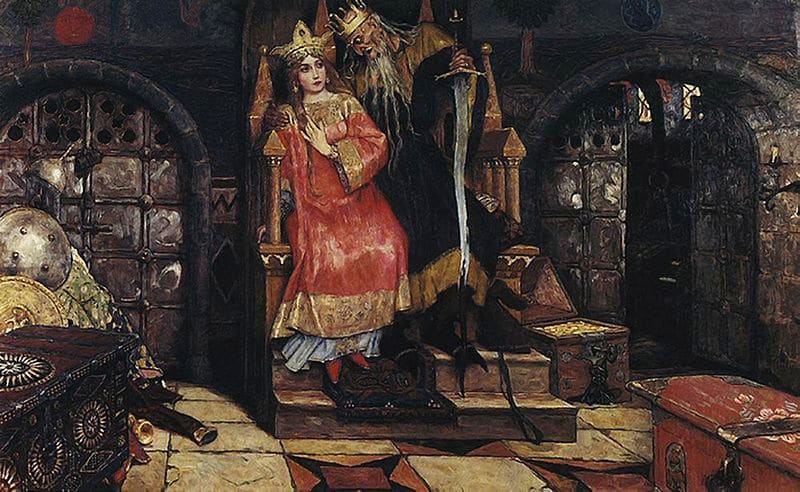
THE FAIRY TALE: The Death of Koschei the Deathless
THE SOURCES: Alexander Afanasyev and The Red Fairy Book
THE MEDIUM: Television
THE SHOW: Grimm
HISTORY AND ANALYSIS
Grimm’s episode last week, titled “Red Menace,” began with the quote, “To kill Koshei the Deathless, first you must find his soul, which is hidden in an egg, in a duck in a lead chest buried beneath an oak tree.” This quote comes from the Russian fairy tale “The Death of Koschei the Deathless,” which was collected by Alexander Afanasyev in his book Narodnye russkie skazkiI. The tale can also be found in Andrew Lang’s The Red Fairy Book. The tale is about an evil immortal man who menaces young women. It begins with the protagonist , Ivan Tsarevitch, who leaves home and marries the beautiful warrior princess, Marya Marevna.
One day Marya declares she must leave for war and that Ivan is to not upon the dungeon door of their castle under any circumstances. Well, as Ivan is a curious fellow, he does not last for long under these orders, and soon opens the dungeon door. Inside he finds Koschei, emaciated and apparently near death. Koschei begs for water from Ivan, who brings him some. After drinking twelve (the magic numbering both Christian and Russian lore) buckets of water, his magic powers return to him and he escapes. Shortly afterwards, Ivan finds out that Koschei has abducted Marya. Ivan goes in search if Koschei, combing the land for his beloved Marya. The first time he meets up with Koschei, he is killed and his remains are thrown into a barrel and into the sea.
Koschei’s sister’s husbands come to his rescue and revive him. They then tell him that he must go get a magic horse from Baba Yaga; Koschei has a magical horse from her. After Ivan goes to visit Baba Yaga and oases her test, he once again meets with Koschei and fights him. This time he kills him and Marya is safely returned to him.
Koschei is also found in other Russian fairy tales and represents an archetypal male antagonist, who is mostly known for abducting the hero’s wife. He is reportedly difficult to kill as his soul is protected in the egg mentioned above. The egg is said to be almost impossible to attain because even if the protagonist can find the oak tree and then the duck, the duck will simply fly away.
THE GOOD
In the Grimm episode last week they dealt with a wessen called a Koschei who was repenting for his previous misdeeds. He does indeed menace young women like the Koschei from the Russian folk tale. He is a womanizer and cheats on his wife. The Koschei in Russian folklore is generally thought to be an older somewhat emaciated man. The man in the episode is definitely stereotyped as the older man type of predator. He goes for younger women who don’t necessarily welcome his attentions.
THE BAD
Well, the old man bit and the name of the wessen is about as close to the original tale as the episode gets. There is nothing else in it that remotely resembles any part of the fairy tale.
THE UGLY
What makes this so much worse is that this particular character is also used in numerous other Russian fairy tales and is an archetypal character. So, the show didn’t even need to necessarily follow the events of any one story. But, they don’t even follow the rules of the character archetype. He is old and menaces women and that’s about as close to the character as you get. However, he doesn’t abduct anyone’s wife, he isn’t emaciated or creepy. I suppose you might call him a wizard-like figure as he is a healer in the episode, but I would say that is a far stretch. He is no feared wizard who terrorizes young women across the land. I think they could have done better with this one.
Do you have a particular analysis of this fairy tale that you would like to share? Sound off below…
RELATED
Read Behind the Fairy Tale: Cinderella versus Ella Enchanted.
ARE YOU A ROMANCE FAN? FOLLOW THE SILVER PETTICOAT REVIEW:
 Our romance-themed entertainment site is on a mission to help you find the best period dramas, romance movies, TV shows, and books. Other topics include Jane Austen, Classic Hollywood, TV Couples, Fairy Tales, Romantic Living, Romanticism, and more. We’re damsels not in distress fighting for the all-new optimistic Romantic Revolution. Join us and subscribe. For more information, see our About, Old-Fashioned Romance 101, Modern Romanticism 101, and Romantic Living 101.
Our romance-themed entertainment site is on a mission to help you find the best period dramas, romance movies, TV shows, and books. Other topics include Jane Austen, Classic Hollywood, TV Couples, Fairy Tales, Romantic Living, Romanticism, and more. We’re damsels not in distress fighting for the all-new optimistic Romantic Revolution. Join us and subscribe. For more information, see our About, Old-Fashioned Romance 101, Modern Romanticism 101, and Romantic Living 101.
